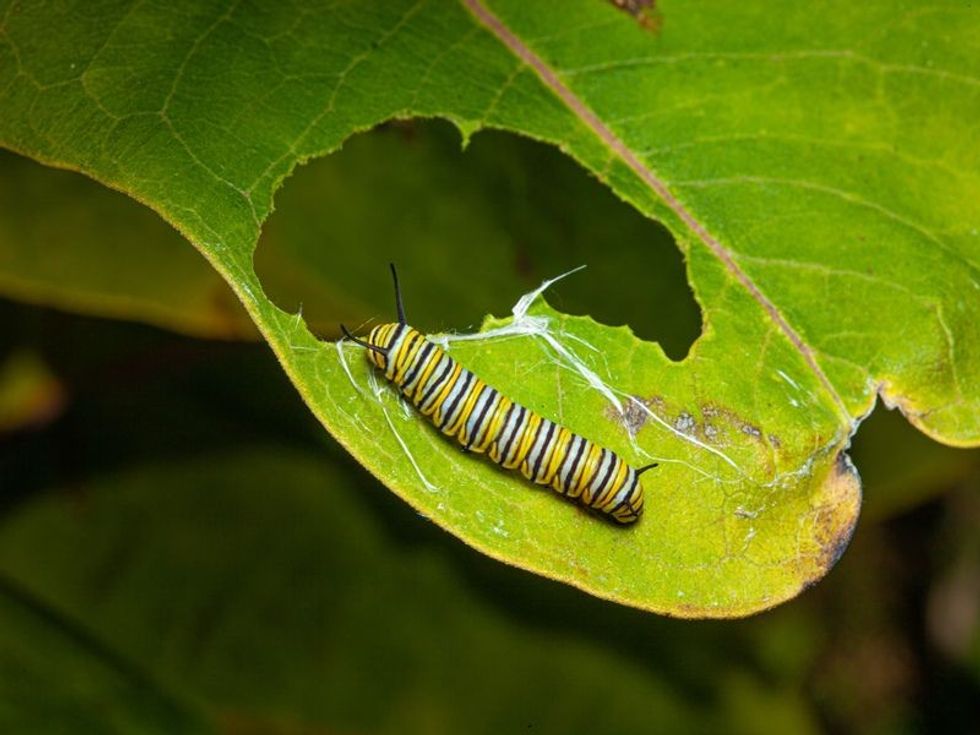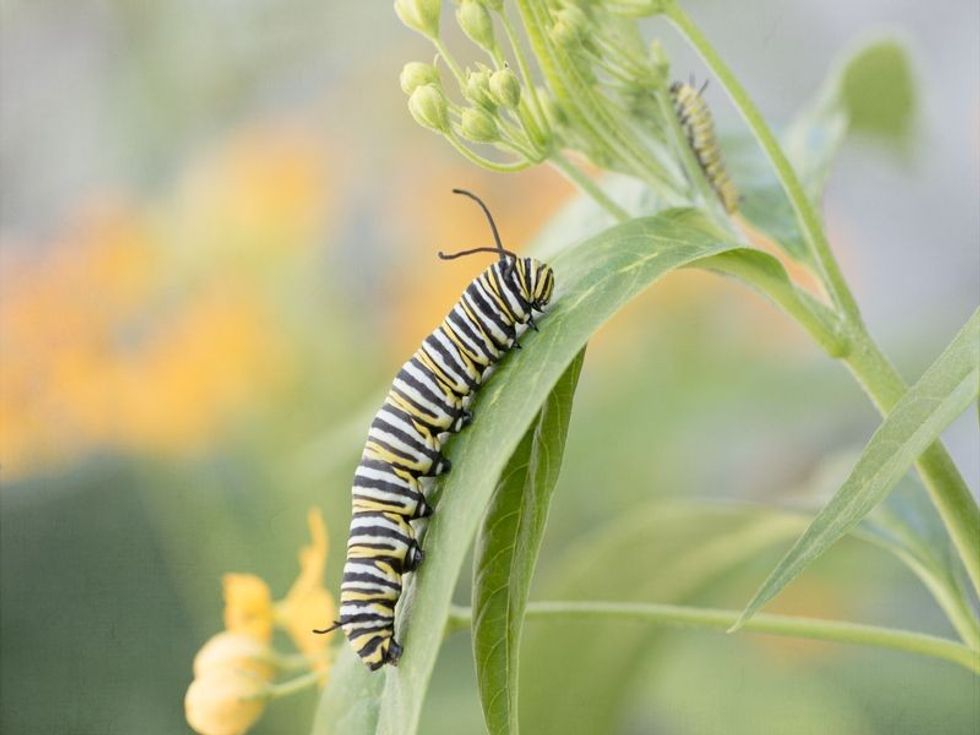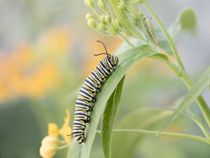Are Caterpillars Poisonous? Avoiding These Fuzzy Green Garden Guests!

Caterpillars are the larva of butterflies, or other species of insect, that feed on tree leaves.
Caterpillars have a bright-colored exterior shell, usually yellow, green or brown. Many caterpillars have urticating spines, meaning that they can cause a reaction when they touch human skin.
A larva is the worm stage before an insect is fully developed into its adult form. The process of converting from one form to another is called 'molting'.
These brown and green insects can have several different larval forms and can go through many mountings before fully reaching their adult form. However, this is not true for all insects. For example, caterpillars go through only one stage before these brown and green insects turn into beautiful butterflies.
Caterpillars come in a variety of colors and sizes. Some are big and hairy, while others can be small and smooth. Caterpillars can be light green, brown, red, yellow, blue, and even have stripes.
It all depends on the species. Some caterpillars are harmless and even good for your garden ecosystem.
However, it is important for us to understand that caterpillars can also be poisonous and even contain venom. For instance, one of the most venomous caterpillars is the puss caterpillar (Megalopyge opercularis) found in Florida, South Carolina, and Texas. The Giant Silkworm moth or the South American caterpillar is also among the most venomous species.
After reading about caterpillar stings and venom, do check our other articles on how many legs does a caterpillar have and what do caterpillars eat.
Is it safe to touch a caterpillar?
'To touch or not to touch, that is the question.'
As we spend time in nature, it is not uncommon to come across these worm-like insects. Some of them might look creepy but others can look very cute.
To children, members of this species can be a source of curiosity, and they often try to touch insects of this species. So, the question is, is it okay to touch caterpillars? If not, then what kind of caterpillars are harmless and which ones should be avoided?
Caterpillars can have a number of local and regional names. These names differ from place to place.
A scientific name is a name that is decided by ICZN (International Code of Zoological Nomenclature). A scientific name remains the same all around the world. These scientific names help us understand the characteristics of organisms so we can learn about different species and families that they belong to.
Believe it or not, a lot of caterpillars found in America are actually safe to touch. An example is Orgyia antigua, which is better known as the Rusty Tussock Moth in the US or The Vapourer moth in the UK.
A lot of caterpillars are pests to small plants and trees. Some examples include hairy caterpillars and stinging caterpillars.
Many caterpillars are covered in urticating hair or spine-like structures on their body. These are called setae.
Stinging caterpillars are usually poisonous. When they come into contact with humans, stinging caterpillars cause inflation, pain, rashes, itching, burning and swelling. The stinging caterpillars that are commonly found in North America and South America include Io moth caterpillars, Puss gypsy caterpillars (Megalopyge opercularis), saddlebacks, stinging rose caterpillars buck moth caterpillars and many more.
Stinging caterpillars found in the US are not highly venomous, just slightly poisonous, and can cause various kinds of irritation. The most common type of irritation that these caterpillars cause is skin irritation.
Moth caterpillars belong to an order of insects called "Lepidoptera". This order includes butterflies and moths.
Insects from this order are some of the most widespread organisms around the world. Moth caterpillars and butterflies have beautiful wings as their distinctive feature. This means that they come in a wide variety of colors such as brown, blue, green, yellow, red, and even multicolored stripes.
Moth caterpillars and butterflies have evolved for hundreds of years to achieve this coloration. Members of this species also play an important role in the ecosystem, and some of the species have a high economic value such as giant silk moths.
How can you tell if a caterpillar is poisonous?
Colorful and fuzzy caterpillars can look very cute and fascinating, but it's important not to be fooled by their appearance. Most fuzzy caterpillars with urticating hair and spikes on their body are either venomous or poisonous.
These stinging caterpillars are becoming a huge problem in America, especially in some southern states such as Florida and the Midwest. The Saddleback caterpillar, buck moth caterpillars, puss caterpillars, and Io moth caterpillars are some of the most venomous caterpillars in the United States.
The Io moth caterpillar has a red and white stripe that runs on the lateral sides of its body. In nature, these markings indicate to other creatures that it is venomous.
The spines on its body put it in the category of stinging caterpillars. A person who decides to touch a stinging caterpillar has to deal with a painful sting, burning sensation, and skin rash. These stinging caterpillars have become fairly common in North America and South America.
You should learn to recognize these caterpillars and avoid touching them. A saddleback caterpillar's sting is one of the most painful.
Members of this species have hollow, poisonous spines on their bodies that are directly connected with poison glands and can cause pain, swelling, and sometimes even fever. Saddleback caterpillar stings are even worse than bee or wasp stings.
The southern flannel moth caterpillar can be the most dangerous to children. Because of its fluffy appearance, children find it very cute and try to touch it.
Flannel moths are also called puss caterpillars or wooly bugs. In conclusion, it's best to avoid touching all fuzzy caterpillars that are covered in hair or spikes, whether they have small hair or large spines. Also, refrain from touching caterpillars that are brightly colored.
These bright caterpillars could be dangerous. The bright ones might be stinging caterpillars, known collectively as"Asp Caterpillars".
The likelihood of them being poisonous, with venomous spines and stinging hairs, is high. Hairless caterpillars with smooth skin are usually safe to touch, for example inchworms and silkworms.
How do caterpillars become poisonous?
Caterpillars can become poisonous for various reasons. Some are naturally poisonous or have venomous spines and stinging hairs, while others turn poisonous due to environmental factors.
Some species of caterpillars have hollow spines, hair and spikes. These hollow, tubular structures are directly connected with poison glands, which are situated under the skin.
The adaption of poisonous spines is a caterpillar's natural defense mechanism. When an organism comes in contact with a caterpillar, its touch receptors activate its defense mechanism.
Next, the spines prick the skin of the 'threat'. These hollow spines function like a straw and the poison from the poison glands is injected into the skin of the organism that came in contact with the caterpillar.
Getting stung by a stinging caterpillar can cause light or moderate to severe pain.
The toxins result in a number of inflammatory symptoms such as allergic reactions, skin rash, burning sensation, nausea, headaches, slight fever and itching. The older these stinging caterpillars are, the more potent their toxin is.
This means that an Io moth caterpillar is most dangerous when it is just about to pupate (a pupa is the dormant form of an Io moth caterpillar before it turns into a full-grown butterfly or moth).
As stated earlier, some examples of stinging caterpillars include the saddleback caterpillar, Io moth, slug caterpillar, flannel moth, buck moth caterpillar, and stinging rose caterpillar.
Some species of caterpillars become poisonous because of the things that they feed on. These North American caterpillars are not poisonous by nature but, as they feed on poisonous plant leaves, they accumulate this poison inside of them.
This poison in moth caterpillar stings does not hurt the moth caterpillar but might be toxic to any other organism that try to eat them.

What should you do if you're stung by a caterpillar?
We have already discussed the types of caterpillars to avoid, but what do you do if you're stung by one regardless? When a stinging caterpillar is rubbed or pressed against a person's skin, venomous spikes prick into the skin and eject toxins.
This results in a number of physiological and skin issues. Usually, the reaction to moth caterpillar poison is mild and limited to skin, such as swelling, rashes, and burning sensations.
The severe pain caused by a moth caterpillar sting usually subsides in an hour and the rash disappears within 2-3 days under normal conditions.
Although, in severe cases, it might lead to respiratory issues, nausea, rapid heart rate, and sometimes the person might even need professional medical assistance. However, you should not feel too worried as these are just extreme cases and their occurrence is very rare.
Here are some directions you can follow in case you or someone around you gets stung by a caterpillar:
The first thing to do is to clean and wash the affected area (where the buck moth caterpillar stings are) with the help of mild soap and water.
The next thing to do is to look carefully and see if any parts of the poisonous sting/ urticating hairs are still stuck or embedded in the skin. If so, then you should try to pull out the buck moth caterpillar hairs with the help of tweezers.
The other thing that you can do is to put tape over the area and pull it off like a waxing strip.
This will also lead to the desired result of removing and hair that is left in your skin. Leaving it on can worsen the situation.
Apply an anti-inflammatory ointment on the affected area to treat the inflammation caused by the flannel moth bite.
You can use isopropyl alcohol, also known as rubbing alcohol to treat the rash caused by a puss caterpillar bite.
Applying calamine lotion can also bring relief to a painful moth caterpillar bite.
Baking soda is a weak base. Applying a baking soda slurry can neutralize the reactions from the poison and help bring down inflammation.
Applying an ice pack wrapped in a thin handkerchief can help to soothe the burning sensation and also bring down the swelling caused by the puss caterpillar bite.
Seek medical attention if any reactions to the puss caterpillar bite are severe and a toxic reaction is witnessed.
Take antihistamines such as Benadryl in case a person is severely allergic to the toxin of flannel moth sting. This may provide some relief from any severe reactions.
Poisonous Caterpillars Vs Venomous Caterpillars
Poisonous animals are the ones that carry around some amount of toxin on the surface of their body and inside their tissues. Monarch butterfly caterpillars are one example. On the other hand, venomous creatures produce and store their poison in special glands. Venomous creatures also have specialized fangs, spines, or setae.
Poison and venom are both toxic substances that are developed in an organism as a defense mechanism. This is a result of evolution over the course of thousands of years.
A lot of animals, including caterpillars, can unknowingly become poisonous during their lifespan, by feeding on toxic substances. However, an animal cannot be venomous due to external factors.
Being venomous is a physiological, anatomical, and morphological trait. From among the examples discussed earlier in this article, the monarch caterpillar is an example of a poisonous caterpillar while stinging caterpillars, such as saddleback caterpillar, Io moth, slug caterpillar, flannel moth, buck moth caterpillar, stinging rose caterpillar, and giant silkworm, fall under the category of venomous caterpillars.
Protecting Your Pets From The Asp Caterpillar
Dogs and cats are very curious animals. At the same time, they happen to be two of the most common pets among domestic animals.
The chances of your pet playing in the garden and coming across an asp caterpillar are somewhat high. There's a reasonable chance of them getting stung by a caterpillar and suffering from a severe and painful sting.
Some species of caterpillar that they are likely to come across are flannel moth caterpillars of North America and asp caterpillars. This can be a problem because curious pets will sniff them out of curiosity.
A good way to prevent this is to avoid taking your dog near vegetation and other places where such caterpillars are commonly found. If you see your pet showing signs of discomfort such as whimpering, changes in behavior, evident welts and swelling, or increased salivation, it's best to check for signs of asp stings.
Paws and nose are some of the likely places where your pet can get stung. Make sure there are no caterpillars sneaking into your house.
Pets can be allergic to toxins just like humans. If your pet shows signs of anaphylactic reaction, such as difficulty in breathing or excessive sweating, take them to a vet immediately.
Here at Kidadl, we have carefully created lots of interesting family-friendly facts for everyone to enjoy! If you liked our suggestions for are caterpillars poisonous then why not take a look at are caterpillars poisonous, or caterpillar facts.
We Want Your Photos!
More for You
Bachelor of Arts specializing in English Literature

Akinwalere OlaleyeBachelor of Arts specializing in English Literature
As a highly motivated, detail-oriented, and energetic individual, Olaleye's expertise lies in administrative and management operations. With extensive knowledge as an Editor and Communications Analyst, Olaleye excels in editing, writing, and media relations. Her commitment to upholding professional ethics and driving organizational growth sets her apart. She has a bachelor's degree in English Literature from the University of Benin, Edo State.
Disclaimer
1) Kidadl is independent and to make our service free to you the reader we are supported by advertising. We hope you love our recommendations for products and services! What we suggest is selected independently by the Kidadl team. If you purchase using the Buy Now button we may earn a small commission. This does not influence our choices. Prices are correct and items are available at the time the article was published but we cannot guarantee that on the time of reading. Please note that Kidadl is a participant in the Amazon Services LLC Associates Program, an affiliate advertising program designed to provide a means for sites to earn advertising fees by advertising and linking to Amazon. We also link to other websites, but are not responsible for their content.
2) At Kidadl, we strive to recommend the very best activities and events. We will always aim to give you accurate information at the date of publication - however, information does change, so it’s important you do your own research, double-check and make the decision that is right for your family. We recognise that not all activities and ideas are appropriate for all children and families or in all circumstances. Our recommended activities are based on age but these are a guide. We recommend that these ideas are used as inspiration, that ideas are undertaken with appropriate adult supervision, and that each adult uses their own discretion and knowledge of their children to consider the safety and suitability. Kidadl cannot accept liability for the execution of these ideas, and parental supervision is advised at all times, as safety is paramount. Anyone using the information provided by Kidadl does so at their own risk and we can not accept liability if things go wrong.
3) Because we are an educational resource, we have quotes and facts about a range of historical and modern figures. We do not endorse the actions of or rhetoric of all the people included in these collections, but we think they are important for growing minds to learn about under the guidance of parents or guardians.







